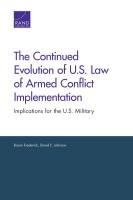| 来源类型 | Research Reports
|
| 规范类型 | 报告
|
| DOI | https://doi.org/10.7249/RR1122
|
| ISBN | 9780833090850
|
| 来源ID | RR-1122-OSD
|
| The Continued Evolution of U.S. Law of Armed Conflict Implementation: Implications for the U.S. Military |
| Bryan Frederick; David E. Johnson
|
| 发表日期 | 2015
|
| 出版年 | 2015
|
| 页码 | 134
|
| 语种 | 英语
|
| 结论 |
Strategic Trends May Make Limiting Civilian Casualties Increasingly Difficult- Urban warfare: Anticipated trends in population growth and urbanization mean that the United States is increasingly likely to face urban operational environments. It is difficult to conduct urban warfare while maintaining low levels of collateral damage, although doing so is widely seen as essential for maintaining political support for military operations.
- Hybrid adversaries: The potential for hybrid adversaries to acquire and learn to effectively employ standoff fire capabilities may limit the United States' ability to conduct precision strikes that minimize civilian casualties.
Anticipated Technological Changes May Only Modestly Increase Usable U.S. Capabilities- Technological advances could give the U.S. military significant new capabilities in the years to come, but the extent to which some of these advances can be used in a manner consistent with the United States' implementation of the LOAC remains in question. This report examines technological trends in autonomous weapon systems, nonlethal weapons, cyber warfare, and space warfare.
Normative Trends May Strengthen Political Pressures to Avoid Collateral Damage- A number of normative or social trends may influence U.S. LOAC implementation, by affecting domestic public or foreign partner support of or adverse reaction to U.S. military activities. The analysis in this report focused on several trends, including domestic reactions to civilian casualties, the diffusion of recording technology, differing partner attitudes, and the deliberate exploitation of U.S. concern for the LOAC by its adversaries. Overall, these trends are likely to increase political pressures on the United States to minimize civilian casualties.
|
| 摘要 |
- To limit the circumstances in which it faces unacceptable choices in the future, the United States should begin to develop policy options to mitigate operational and political risks. The following options are briefly discussed in the report: precision micromunitions, usable nonlethal weapons, greater diplomatic engagement, wearable cameras for U.S. forces, and enhanced political and legal focus on adversary LOAC violations.
- Further research is needed on how the United States can most effectively combine the pursuit of its strategic interests with evolving political pressures and its enduring commitment to the LOAC.
|
| 主题 | Global Security
; International Humanitarian Law
; Law of War
; Military Doctrine
; Warfare and Military Operations
|
| URL | https://www.rand.org/pubs/research_reports/RR1122.html
|
| 来源智库 | RAND Corporation (United States)
|
| 引用统计 |
|
| 资源类型 | 智库出版物
|
| 条目标识符 | http://119.78.100.153/handle/2XGU8XDN/107992
|
推荐引用方式
GB/T 7714 |
Bryan Frederick,David E. Johnson. The Continued Evolution of U.S. Law of Armed Conflict Implementation: Implications for the U.S. Military. 2015.
|
|
文件名:
|
x1495316228115.jpg
|
|
格式:
|
JPEG
|

|
文件名:
|
RAND_RR1122.pdf
|
|
格式:
|
Adobe PDF
|
除非特别说明,本系统中所有内容都受版权保护,并保留所有权利。